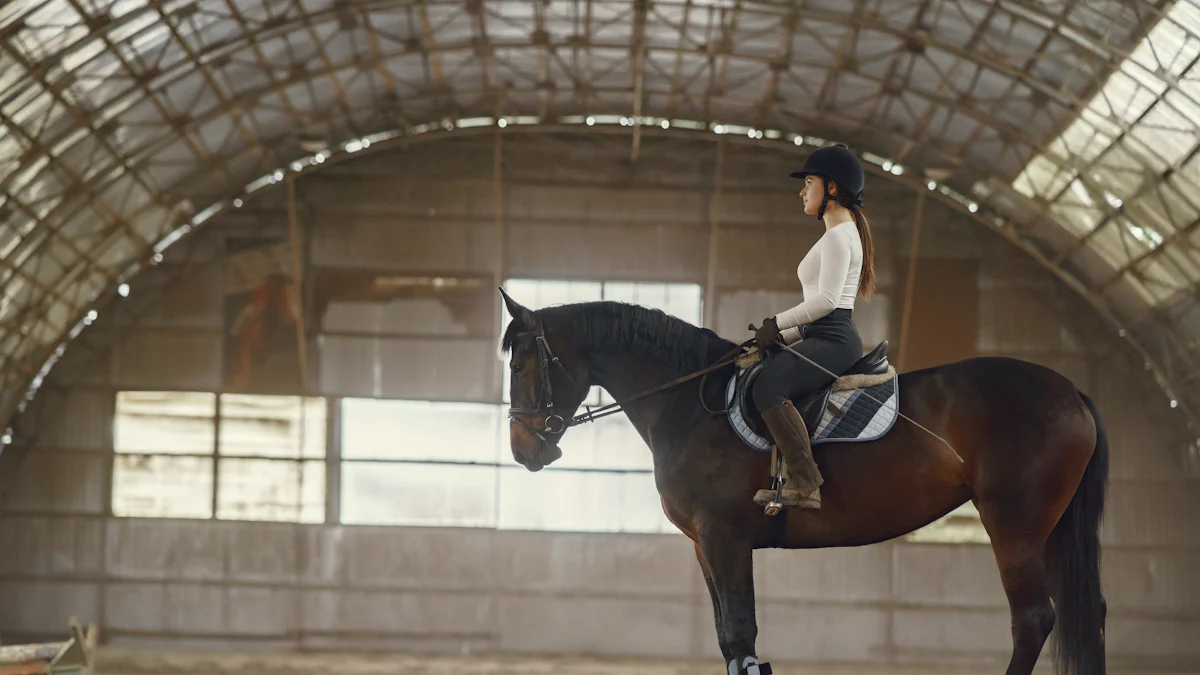Why Proper Riding Posture Improves Comfort
Table of Contents
-
Motorcycle Flag Mounts
Motorcycle 1 1/4″ Highway Engine Guard Crash Bar For Harley Sportster XL 1200 883 2004-2021
$149.99 – $259.99 This product has multiple variants. The options may be chosen on the product pageRated 0 out of 5 -
Motorcycle Flag Mounts
Motorcycle LED Saddlebag Lid Spoiler Kit For Harley Touring Road King Electra Glide Street Road Glide 2014-2024
$67.99Rated 0 out of 5 -
Flag Mounts & Flags
2Pack Support Breast Cancer Awareness with Stylish Harley Davidson Motorcycle Flags
$19.99Rated 0 out of 5 -
Flag Mounts & Flags
2Pack Breast Cancer Awareness Harley DavidsonMotorcycle Flag – Ride with Purpose
$19.99Rated 0 out of 5

Have you ever noticed how your body feels after a long ride? The way you sit on your bike can make all the difference. Proper riding posture keeps your muscles relaxed and reduces strain on your back and joints. When your spine stays aligned, it prevents tension from building up in your neck and shoulders. On the other hand, poor posture often leads to discomfort, fatigue, and even chronic pain over time. By focusing on how you position yourself, you can enjoy smoother, more comfortable rides without unnecessary aches.
Key Takeaways
Maintaining a straight spine while riding helps distribute weight evenly, reducing strain on your back and preventing discomfort.
Relaxed arm positioning and a loose grip on the handlebars enhance control and prevent fatigue in your wrists and forearms.
Engaging your core muscles acts as a natural brace for your spine, improving balance and reducing strain during rides.
Regularly checking and adjusting your posture can prevent stiffness and enhance your overall riding experience.
Investing in ergonomic accessories, like padded seats and grips, can significantly improve comfort on long rides.
Practicing good posture habits not only benefits your riding but also promotes better alignment in your daily life.
What Is Proper Riding Posture?

Riding a motorcycle isn’t just about hitting the road; it’s about how you position your body while doing so. A proper posture can make or break your riding experience. It keeps you comfortable, reduces strain, and ensures you stay in control. Let’s break down what makes a good posture and why it matters.
Key Elements of Proper Riding Posture
Back alignment and maintaining a straight spine
Your back is the foundation of your riding posture. Keeping your spine straight helps distribute your weight evenly, reducing pressure on your lower back. When you slouch or hunch over, tension builds up in your neck and shoulders, which can lead to back pain. I’ve found that sitting upright not only feels better but also keeps me more alert during rides. Think of your spine as the anchor that holds everything in place.
Relaxed arm positioning and proper grip
Your arms should feel loose, not stiff. A relaxed grip on the handlebars allows for smoother control and prevents fatigue in your wrists and forearms. I always remind myself to keep my elbows slightly bent. This positioning absorbs shocks from the road and keeps my shoulders from tensing up. Gripping too tightly can tire you out quickly, so let your hands rest naturally on the controls.
Leg placement and foot positioning for stability
Your legs play a bigger role than you might think. Keeping your knees close to the tank gives you better stability, especially during turns. Your feet should rest comfortably on the footpegs, with the balls of your feet providing support. I’ve noticed that proper leg placement not only improves balance but also reduces strain on my hips and thighs during long rides.
The Importance of Core Engagement
Supporting the spine to reduce strain
Your core muscles act like a natural brace for your spine. Engaging them while riding helps reduce the strain on your back. I’ve learned that even a slight activation of my core makes a huge difference in how my body feels after a ride. It’s like having built-in support that keeps you upright without relying solely on your back muscles.
Enhancing balance and control during rides
A strong core doesn’t just protect your back; it also improves your balance. When your core is engaged, you can shift your weight more effectively, making it easier to handle curves and sudden stops. I’ve found that this added control makes me feel more confident on the road. It’s not about tensing up—it’s about staying steady and responsive.
Pro Tip: Think of your posture as a system where every part of your body works together. From your back to your legs, each element plays a role in keeping you comfortable and in control.
Why Does Riding Posture Matter for Comfort?
Riding a motorcycle should feel like freedom, not a battle against discomfort. The way you sit and position your body plays a huge role in how enjoyable your ride becomes. Let’s dive into why proper riding posture makes all the difference.
Reducing Physical Strain
Preventing back pain and muscle tension
I’ve learned that poor posture on a bike can quickly lead to back pain. Slouching or hunching over puts unnecessary pressure on your spine and muscles. Keeping your back straight and aligned helps distribute your weight evenly, which reduces tension. I’ve noticed that when I sit upright, my neck and shoulders feel less stiff after a ride. It’s like giving your body a break while still enjoying the road.
Dr. Ginger Edgecombe Dorsey, an expert in ergonomics, explains that “poor driving posture can lead to an increased risk of discomfort in the neck, back, shoulders, arms, wrists, fingers, legs, and feet.” This shows how critical alignment is for avoiding pain.
Minimizing fatigue on long rides
Long rides used to leave me feeling drained, but I realized it wasn’t just the distance—it was my posture. When you sit incorrectly, your muscles work overtime to compensate, which leads to fatigue. By maintaining good posture, I’ve found that my energy lasts longer. My core supports my body, and my arms and legs don’t feel as tired. It’s amazing how small adjustments can make a big difference.
Improving Control and Safety
Better handling and maneuverability
Proper posture doesn’t just keep you comfortable—it also improves how you handle your bike. When I keep my back straight and my arms relaxed, I feel more in control. My movements become smoother, and I can react faster to changes in the road. Keeping my knees close to the tank and my feet positioned correctly gives me better stability, especially during sharp turns.
Pro Tip: Think of your posture as part of your bike’s suspension system. A balanced and aligned body absorbs shocks better, making your ride feel smoother and safer.
Faster reaction times in emergencies
Emergencies on the road demand quick reflexes. I’ve noticed that when my posture is off, my reaction time slows down. A straight spine and engaged core keep me alert and ready to respond. Whether it’s braking suddenly or swerving to avoid an obstacle, proper posture ensures I stay in control. It’s not just about comfort—it’s about safety too.
Promoting Long-Term Health
Avoiding chronic pain and injuries
Bad posture doesn’t just cause discomfort during rides—it can lead to long-term issues. Over time, poor alignment can result in chronic pain in your back, neck, and shoulders. I’ve seen how consistent good posture has helped me avoid these problems. It’s like investing in your body’s future health. Riding shouldn’t come at the cost of your well-being.
Physical therapists often emphasize the importance of maintaining optimal alignment. They explain that “proper posture minimizes the risk of pain and injuries associated with poor habits.”
Encouraging better posture habits off the bike
What I’ve found fascinating is how riding posture influences my daily life. When I practice good posture on my bike, it carries over to how I sit, stand, and move throughout the day. My back feels stronger, and I’m more aware of my alignment. It’s like riding becomes a training ground for better habits overall.
How to Adjust Your Riding Posture
Finding the right riding posture isn’t just about how you sit—it’s about making adjustments that suit your body and riding style. Over time, I’ve learned that small tweaks to your bike setup and posture habits can make a huge difference in comfort and control. Let me walk you through some practical steps to get it right.
Optimizing Your Bike Setup
Your bike should feel like an extension of your body. If something feels off, it’s probably time to make some adjustments.
Adjusting seat height and angle for proper alignment
The seat height plays a big role in maintaining good posture. When your seat is too high or too low, it can strain your knees and back. I always make sure my seat allows my legs to extend comfortably without locking my knees. The angle matters too. A slightly tilted seat can relieve pressure on sensitive areas, making long rides much more comfortable.
Tip: Consider ergonomic saddles designed to distribute weight evenly. They reduce pressure on your lower back and hips, which helps prevent discomfort during extended rides.
Positioning handlebars for a relaxed reach
Handlebars that are too far or too close can throw off your posture. I’ve found that adjusting them to a height where my arms stay slightly bent keeps my shoulders relaxed. A higher handlebar position works best for comfort, while a lower one suits riders looking for speed. It’s all about finding what feels natural for you.
Aligning mirrors to reduce neck strain
Constantly craning your neck to check mirrors can lead to stiffness. I always adjust my mirrors so I can see clearly without moving my head too much. This simple step keeps my neck relaxed and reduces strain, especially on longer rides.
Pro Tip: Regularly check your bike’s setup. Even small changes in your riding habits or gear can affect how your bike fits you.
Practicing Good Posture Techniques
Even with the perfect bike setup, your posture habits matter just as much. Here’s how I keep mine in check.
Keeping your back straight and shoulders relaxed
A straight back is the foundation of proper posture. I focus on sitting upright, with my shoulders down and relaxed. Slouching might feel comfortable at first, but it leads to tension over time. Staying aligned keeps my back pain-free and helps me stay alert on the road.
Engaging your core muscles for support
Your core acts like a built-in support system. I’ve noticed that when I engage my core, my back feels less strained, even on bumpy roads. It doesn’t take much—just a slight tightening of your abdominal muscles can make a big difference.
Regularly checking and correcting your posture
It’s easy to slip into bad habits during a ride. I make it a point to check my posture every so often. Am I slouching? Are my shoulders creeping up? A quick mental check helps me stay aligned and comfortable.
Reminder: Good posture isn’t about being rigid. Stay relaxed and let your body move naturally with the bike.
Using Accessories for Comfort
Sometimes, the right gear can take your comfort to the next level. Here are a few accessories I swear by.
Padded seats and ergonomic grips
A padded seat can work wonders for your comfort, especially on long rides. I also use ergonomic grips to reduce pressure on my hands and wrists. These small upgrades make a big difference in how my body feels after a day on the road.
Back braces for extended rides
For longer trips, I sometimes wear a back brace. It provides extra support and helps me maintain proper posture, even when fatigue sets in. It’s like having a safety net for your spine.
Did You Know? Accessories like ergonomic saddles and grips are designed to address common issues like numbness and pressure points. They’re worth considering if you ride often.
By optimizing your bike setup, practicing good posture techniques, and using the right accessories, you can transform your riding experience. These adjustments not only improve comfort but also help you stay in control and enjoy the journey.
The Consequences of Poor Riding Posture
Riding a motorcycle should feel like freedom, but poor posture can turn that joy into discomfort and even long-term health issues. I’ve experienced firsthand how bad habits on the bike can creep up on you, leaving your body stiff and drained. Let’s break down the real consequences of poor riding posture and why it’s worth addressing.
Physical Discomfort and Back Pain
Stiffness and tension in the back, neck, and shoulders
When I used to slouch or hunch over during rides, I’d feel it almost immediately in my back and shoulders. That stiffness would linger long after I got off the bike. Poor alignment forces your muscles to work harder than they should, leading to tension that builds up in your neck and upper back. Over time, this strain can make even short rides feel unbearable.
Fun Fact: Did you know that bad posture doesn’t just affect you? Riders with poor alignment can also impact their bike’s performance, as uneven weight distribution can throw off balance and handling.
Increased risk of chronic pain over time
Ignoring posture issues doesn’t just cause temporary discomfort—it can lead to chronic pain. I’ve met riders who developed long-term back pain because they didn’t address their riding habits early on. The constant strain on your spine and muscles can result in conditions like herniated discs or persistent shoulder pain. Trust me, it’s not worth the risk. A small adjustment today can save you from years of discomfort.
Reduced Endurance and Fatigue
Strain on muscles and joints
Bad posture doesn’t just hurt—it drains your energy. When your body isn’t aligned, your muscles and joints take on extra work to keep you stable. I’ve felt this during long rides when my shoulders and lower back would ache from compensating for poor positioning. It’s like carrying an invisible weight that wears you down faster than you’d expect.
Decreased energy levels during rides
I used to wonder why I felt so exhausted after relatively short trips. Then I realized my posture was the culprit. Slouching or gripping the handlebars too tightly saps your energy because your body isn’t working efficiently. Once I started sitting upright and relaxing my arms, I noticed a huge difference. My energy lasted longer, and I could enjoy the ride without feeling drained.
Pro Tip: If you’re feeling unusually tired after a ride, take a moment to evaluate your posture. Small tweaks can make a big difference in how your body feels.
Compromised Safety and Control
Difficulty handling the bike effectively
Poor posture doesn’t just affect your comfort—it impacts your control over the bike. I’ve noticed that when I slouch or let my knees drift away from the tank, my handling becomes less precise. Proper posture keeps your body aligned with the bike, making it easier to maneuver through turns and maintain stability. Without it, even simple movements can feel clumsy.
Slower reaction times in critical situations
Emergencies on the road demand quick reflexes, and bad posture slows you down. When your body isn’t balanced, it takes longer to shift your weight or adjust your grip. I’ve experienced this during sudden stops, where poor alignment made it harder to react in time. Keeping your spine straight and your core engaged ensures you’re ready for anything the road throws your way.
Reminder: Riding posture isn’t just about comfort—it’s a key factor in staying safe and in control. Don’t underestimate its importance.
Tips for Maintaining Proper Riding Posture on Long Rides

Long rides can be thrilling, but they also test your endurance. I’ve learned that maintaining a healthy posture throughout the journey makes all the difference. Here are some practical tips to help you stay comfortable and in control during those extended hours on the road.
Take Regular Breaks
Sitting in one position for too long can make your muscles stiff and tired. I always plan short breaks during my rides to keep my body feeling fresh.
Stretching to relieve muscle tension
When I stop, I take a few minutes to stretch. Simple moves like reaching for the sky or bending side to side loosen up my back and shoulders. Stretching helps release the tension that builds up from staying in the same posture for hours. It’s a quick way to feel re-energized.
Walking to improve circulation
A short walk works wonders for circulation. I’ve noticed that even a five-minute stroll helps reduce stiffness in my legs and hips. Walking gets the blood flowing again, which keeps my muscles from cramping. It’s a small effort that pays off big time on long rides.
Monitor Your Posture Continuously
Even with the best intentions, it’s easy to slip into bad habits while riding. I’ve found that staying mindful of my posture keeps me comfortable and alert.
Use mental reminders to check alignment
I like to set mental checkpoints during my ride. Every so often, I ask myself, “Is my back straight? Are my shoulders relaxed?” These quick reminders help me maintain good posture without overthinking it. It’s like giving myself a gentle nudge to stay aligned.
Adjust your position as needed during the ride
Sometimes, I shift slightly in my seat to stay comfortable. Small adjustments, like repositioning my hands or rolling my shoulders, prevent stiffness from setting in. I’ve learned that staying flexible with my posture keeps me feeling good, even on longer trips.
Stay Physically Fit
Riding demands more from your body than you might think. Keeping your core and back strong ensures you can handle the physical challenges of long rides.
Strengthening core and back muscles
I make it a point to include core exercises in my routine. Planks and crunches have helped me build the strength I need to support my spine while riding. A strong core acts like a natural brace, reducing strain on my back and helping me stay steady on the bike.
Improving flexibility with stretching exercises
Flexibility is just as important as strength. I’ve added stretches like hamstring and hip flexor stretches to my daily routine. These exercises improve my range of motion, making it easier to maintain good posture on the bike. Staying flexible keeps my body ready for the demands of the road.
Pro Tip: Think of your body as part of your riding gear. Just like you maintain your bike, keeping your body fit and flexible ensures a smoother, more enjoyable ride.
Debunking Myths About Riding Posture
Riding posture often gets overlooked, especially by casual riders. Over the years, I’ve heard plenty of misconceptions about what makes a good riding posture. Let’s clear up some of these myths and get to the truth about why proper alignment matters for everyone.
“Comfortable posture is always the best posture”
Why comfort doesn’t always mean correct alignment
Many riders assume that if they feel comfortable, their posture must be right. I used to think the same way. I’d slouch slightly or lean forward because it felt natural at the time. But I quickly learned that comfort doesn’t always equal proper alignment. Bad posture, even if it feels okay in the moment, can lead to long-term issues like back pain or muscle fatigue.
Proper posture might feel a bit unfamiliar at first, especially if you’re used to slouching. But once I started sitting upright with my spine straight and my core engaged, I noticed a huge difference. My rides became smoother, and I didn’t feel as stiff afterward. Correct alignment distributes your weight evenly, which reduces strain on your muscles and joints. It’s not just about feeling good now—it’s about protecting your body for the future.
Quick Tip: If you’re unsure whether your posture is correct, take a photo or video of yourself while riding. Compare it to examples of proper posture to spot areas for improvement.
“Posture doesn’t matter for short rides”
How even short rides can lead to strain over time
I used to think posture only mattered for long trips. After all, how much harm could a quick ride do? Turns out, quite a bit. Even short rides can cause strain if your posture is off. I’ve felt tension in my neck and shoulders after just a 20-minute commute because I wasn’t paying attention to how I was sitting.
The problem with bad habits is that they build up over time. A little slouching here, a tight grip there—it all adds up. Before you know it, you’re dealing with chronic discomfort. I’ve found that practicing good posture on every ride, no matter how short, helps me stay consistent. It’s like muscle memory. The more you do it, the easier it becomes.
Did You Know? Experts in ergonomics emphasize that even brief periods of poor alignment can contribute to long-term issues like stiffness and joint pain. Consistency is key.
“Only professional riders need to worry about posture”
Why proper posture is essential for all riders
This myth couldn’t be further from the truth. I’ve heard people say, “I’m not a racer, so why should I care about posture?” But proper alignment isn’t just for professionals—it’s for anyone who wants to ride comfortably and safely. Whether you’re cruising around town or tackling a cross-country trip, your posture affects everything from your control to your endurance.
When I started focusing on my posture, I noticed immediate benefits. My handling improved, and I felt more stable during turns. Proper posture also keeps you alert, which is crucial for reacting to sudden changes on the road. It’s not about looking like a pro; it’s about riding smarter and protecting your body.
Pro Insight: Correct posture doesn’t just benefit you—it also improves your bike’s performance. When your weight is balanced, your motorcycle handles better, making your ride safer and more enjoyable.
Riding with good posture transforms every journey into a more enjoyable experience. I’ve noticed how small adjustments, like keeping my back straight and engaging my core, have reduced back pain and made long rides less tiring. A healthy posture doesn’t just improve comfort—it enhances control and keeps you safer on the road. By focusing on your riding posture and fine-tuning your habits, you’ll not only avoid discomfort but also protect your body for years to come. Prioritize posture, and every ride becomes smoother, longer, and more rewarding.
FAQ
What is the correct riding posture?
Correct riding posture means sitting with a neutral spine. Your back shouldn’t be overly arched or completely flat. Instead, it should have a slight natural curve. Align your shoulders, hips, and heels vertically. Imagine a straight line running through these points—it should intersect all three. Keep your head and neck neutral, not tipped back or slouched forward. Relax your hands, arms, and fingers. This alignment helps distribute your weight evenly, reducing strain and improving control.
Think of your posture as the foundation for a smooth ride. When your body is aligned, you feel more stable and connected to your bike.
How can I tell if my riding posture is correct?
Pay attention to how your body feels during and after a ride. If you experience stiffness in your back, neck, or shoulders, your posture might need adjustment. Check if your spine stays straight and your shoulders remain relaxed. Your knees should grip the tank lightly, and your feet should rest comfortably on the footpegs. A quick way to evaluate is to ask someone to take a photo of you while riding. Compare it to examples of proper posture to spot any misalignments.
Why does my back hurt after riding?
Back pain often comes from poor posture. Slouching or hunching over puts extra pressure on your spine and muscles. Over time, this strain leads to discomfort. Adjust your seat height and angle to support a straight spine. Engage your core muscles to reduce the load on your back. Small changes, like keeping your shoulders relaxed and your knees close to the tank, can make a big difference.
Pro Tip: Regular stretching before and after rides can help prevent stiffness and keep your back feeling strong.
How do I maintain good posture on long rides?
Long rides can challenge even the best posture. Take regular breaks to stretch and walk around. Use mental reminders to check your alignment—ask yourself, “Is my back straight? Are my shoulders relaxed?” Adjust your position slightly during the ride to avoid stiffness. Strengthening your core and back muscles through exercises like planks can also help you maintain proper posture for extended periods.
What accessories can improve riding comfort?
Accessories like padded seats and ergonomic grips can significantly enhance your comfort. A padded seat reduces pressure on your lower back and hips, while ergonomic grips minimize strain on your wrists. For longer rides, consider using a back brace for added support. If you’re looking to personalize your bike, Harley Davidson flag mounts are a great addition. They not only add style but also let you showcase your personality on the road.
Are Harley Davidson flag mounts worth it?
Absolutely! Harley Davidson flag mounts are more than just decorative. They let you express your individuality while riding. These mounts are durable and designed to withstand various weather conditions. Whether you’re showing off your favorite flag or adding a touch of flair to your bike, they’re a practical and stylish upgrade. Plus, they’re easy to install and compatible with most Harley models.
Does posture matter for short rides?
Yes, even short rides can strain your body if your posture is off. Slouching or gripping the handlebars too tightly can lead to tension in your neck and shoulders. Practicing good posture on every ride, no matter how short, helps build muscle memory. Over time, this consistency prevents discomfort and keeps your body aligned.
How can I improve my core strength for better posture?
Core strength plays a huge role in maintaining proper posture. Exercises like planks, crunches, and bridges target your abdominal and lower back muscles. These moves create a natural brace for your spine, reducing strain during rides. Stretching exercises, such as hamstring and hip flexor stretches, improve flexibility and make it easier to stay aligned on the bike.
What’s the best way to adjust my bike for better posture?
Start by adjusting your seat height and angle. Your feet should rest comfortably on the footpegs, and your knees should bend slightly without locking. Position the handlebars so your arms stay relaxed and slightly bent. Align your mirrors to reduce neck strain. These small tweaks ensure your bike fits your body, making it easier to maintain good posture.
Remember, your bike should feel like an extension of your body. If something feels off, don’t hesitate to make adjustments.
Can bad posture affect my bike’s performance?
Yes, poor posture impacts more than just your comfort. Misalignment can throw off your weight distribution, making your bike harder to handle. Slouching reduces your ability to react quickly in emergencies. Proper posture keeps your body balanced, improving stability and control. When you ride with good alignment, your bike performs better, and you stay safer on the road.








